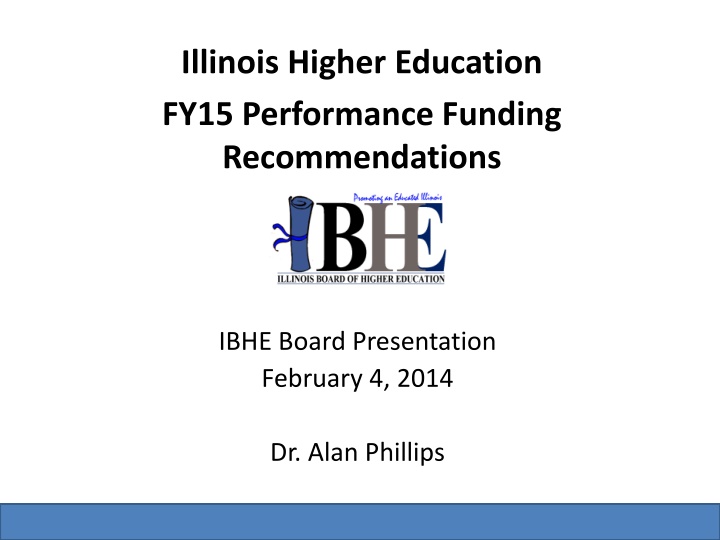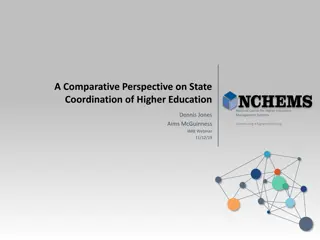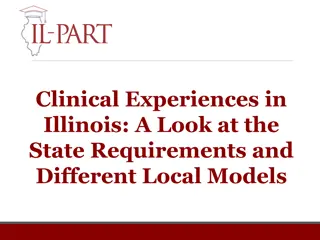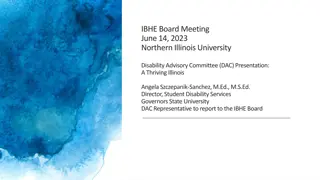Performance Funding Models in Illinois Higher Education
The Illinois Board of Higher Education (IBHE) is developing performance funding models for public universities and community colleges. These models are directly linked to the goals of the Illinois Public Agenda and Public Act 97-320. The objective is to reward institutions based on student success metrics, including completion rates for at-risk, first-generation, and low-income students. Community colleges are evaluated based on measures like degree completion, transfer rates, and adult education. The funding allocations are tied to performance improvements, encouraging institutions to enhance student outcomes and maintain educational quality.
Download Presentation

Please find below an Image/Link to download the presentation.
The content on the website is provided AS IS for your information and personal use only. It may not be sold, licensed, or shared on other websites without obtaining consent from the author.If you encounter any issues during the download, it is possible that the publisher has removed the file from their server.
You are allowed to download the files provided on this website for personal or commercial use, subject to the condition that they are used lawfully. All files are the property of their respective owners.
The content on the website is provided AS IS for your information and personal use only. It may not be sold, licensed, or shared on other websites without obtaining consent from the author.
E N D
Presentation Transcript
Illinois Higher Education FY15 Performance Funding Recommendations IBHE Board Presentation February 4, 2014 Dr. Alan Phillips
Performance Funding Objective To develop performance funding models for public universities and community colleges that are Linked directly to the Goals of the Illinois Public Agenda and the principles of Public Act 97-320 Equipped to recognize and account for each university s mission and set of circumstances Adjustable to account for changes in policy and priorities Not prescriptive in how to achieve excellence and success IBHE Presentation 2
Public Act 97-320 (HB 1503) Performance Metrics Shall: Focus on the fundamental goal of increasing completion. Reward performance of institutions in advancing the success of students who are: Academically or financially at risk. First generation students. Low-income students. Students traditionally underrepresented in higher education. Recognize and account for the differentiated missions of institutions of higher education. Maintain the quality of degrees, certificates, courses, and programs. Recognize the unique and broad mission of public community colleges. IBHE Presentation 3
Performance Funding Model Community Colleges IBHE Presentation 4
Performance Funding Model (Community Colleges) There are thirty-nine community college districts. The community college model contains six separate measures. Each measure is allocated an equal portion of the total performance funding amount. Each college competes for a portion of the funding for each measure. Those colleges that show a decrease in performance receive no funds based on performance. Those colleges that show an increase in performance receive a pro-rata share of the funding allocation for that measure based on the increase in their performance. IBHE Presentation 5
Performance Funding Measures (Community Colleges) 1. Degree and Certificate Completion. 2. Degree and Certificate Completion of At Risk students. 3. Transfer to a four year institution. 4. Remedial and Adult Education Advancement. 5. Momentum Points. 6. Transfer to a community college. IBHE Presentation 6
Performance Funding Model 4-Year Public Universities IBHE Presentation 7
Performance Funding Model Steps (4-Year Public University) Step 1 Identify the performance measures or metrics that support the achievement of the state goals. Step 2 Collect the data on the selected performance measures. Step 3 Award an additional premium for the production of certain desired outcomes such as completions by underserved or underrepresented populations Step 4 Normalize (scale) the data, if necessary, so it is comparable across variables. Step 5 Weight each of the Performance Measures to reflect the priority of the Measure to the mission of the institution. Step 6 Multiply and sum the Scaled Data times the Weight to produce the Weighted results. Step 7 Use the final Weighted results (or Total Performance Value) - excluding high cost entities - to distribute performance funding. Step 8 Add an adjustment factor (Carve-out) for high cost entities (i.e. Hospitals, Medical, Dental, and Veterinary Schools). IBHE Presentation 8
Sub-Categories Step 3 Award an additional premium for the production of certain desired outcomes such as completions by underserved or underrepresented populations Only weighted Bachelors, Masters, and Doctorate and Professional Degrees Did not weight Undergraduate Degrees per 100 FTE - To avoid overweighting sub-populations throughout the model, the percentage weight given to the subcategories would have to be reduced from the current 40%. Otherwise, schools with high numbers of Master and Doctoral students graduating from the subpopulations would be negatively impacted, as credit given to these populations is reduced. - The change would benefit smaller masters degree schools but would disproportionately harm research institutions and those institutions with higher levels of masters and doctoral students. Did not weight Cost per Completion - It is only possible to weight the completion portion of the ratio, a weighted cost is unavailable. Weighting completions without weighting cost does not provide an accurate measure of differential costs to educate particular sub groups. IBHE Presentation 9
Performance Value Calculation Step 8 Add an adjustment factor for high cost entities (i.e. Hospitals, Medical, Dental, and Veterinary Schools) Step 1: Allocate performance set-aside funds based on and adjusted state appropriation that removes state funds for high cost entities. Step 2: Calculate performance funding allocations per funding model using adjusted performance set-aside amount. Step 3: Add back funds to institutions with high cost entities by applying performance funding set-aside percentage (i.e. .5% for FY14) to the high cost entities state appropriation. Step 4: Total allocated funds equal performance funding without high cost entities plus set-aside for high cost entities. IBHE Presentation 10
Performance Measures Measures Bachelors Degrees (FY10-12) Masters Degrees (FY10-12) Doctoral and Professional Degrees (FY10-12) Undergraduate Degrees per 100 FTE (FY10-12) Research and Public Service Expenditures (FY11-13) Graduation Rate - 150% of Time (Fall 05-07 Cohort)* Persistence- 24 Credit Hours Completed in One Year (FY10-12) Cost per Credit Hour (FY10-12) Cost per Completion (FY10-12) *Incorporate transfers per the CCA transfer category definitions (i.e. 30 or fewer credits, 31 to 59 credits, or 60 or more credits). IBHE Presentation 11
Sub-Categories Sub-Category Low Income (Pell/Map Eligible) Adult (Age 25 and Older) Hispanic Black, non-Hispanic STEM & Health Care (by CIP Code) 40% - HLS* + CIP 51 Weight* 40% 40% 40% 40% * Homeland Security IBHE Presentation 12
Results for FY15 Performance funding values increased for eight of the twelve four-year public universities from FY14 to FY15. Based on their performance, the majority of the schools earned back most or all of their performance funding set-aside. IBHE Presentation 13
Results for FY15 Assuming a .5% funding set-aside and level GRF Funding (Step 1): Variance in funding allocations due to performance ranged from +.19% to -.11%. The actual funding amount variance ranged from +$110.3K to -$93.3K. Assuming a 2.0% funding increase in addition to level GRF Funding (Step 2): Variance in funding allocations due to performance ranged from +1.58% to +2.74%. The actual funding amount variance ranged from +$.458M to +$6.0M. IBHE Presentation 14
FY15 Budget Recommendations IBHE Presentation 15
Proposed Performance Funding Step Budget Recommendation Step 1 Flat or Level Budget from FY 13 Funding. 4-Year Universities - Flat funding with no more than 0.5% of the budget reallocated for Performance Funding (approx $6.15M). 2-Year Colleges Flat funding with $360K reallocated based on the six community college performance measures. Step 2 Overall funding is a 2.5% increase over FY 13. 4-Year Universities Total increase of $24.6M (2.0%). Of the total, $12.3M (1.0%) is allocated for performance funding. 2-Year Colleges Total increase of $5.8M (2.0%), including a one-time $1.2M reallocation for legislative initiatives, with $360K reallocated based on the six community college performance measures. IBHE Presentation 16
Proposed Performance Funding Step Budget Recommendation Step 3 A 4.5 % increase above the FY 13 Funding Level 4-Year Universities The total increase is $49.2M (4.0%), $24.6M (2.0%) to Performance Funding, $24.6M (2.0%) to core institutional support. 2-Year Colleges The total increase is $11.6M (4.0%), including $1.2M reallocation, $360K to Performance Funding, $8.1M to Base Operating Grants, and $3.8M to Equalization Grants. Step 4 An 8.3% increase above the FY 13 Funding Level (Restoration to roughly FY 12 funding levels). 4-Year Universities The total increase is $79.6M (6.5%), $24.6M to Performance Funding, $30.4M to Deferred Maintenance, and $24.6M to Institutional support. 2-Year Colleges The total increase is $20.8M (7.2%), including $1.2M reallocation, $360K to Performance Funding, $13.0M to Base Operating Grants, and $7.7M to Equalization Grants. IBHE Presentation 17
Performance Funding Model (4-Year Universities) The model effectively balances the competing goals of increasing completions while rewarding institutions for improving the success of underserved populations. All steps are identical at each university, and each institution s formula is calculated independently The model accounts for each institution s unique mission by adding a weight to each measure. Funds are distributed on a pro rata basis according to each institution s formula calculation. The formula calculation for each institution will change each year based on annually updated data. The model is not prescriptive in how to achieve excellence and success (what, not how). IBHE Presentation 18
Questions/Comments? IBHE Presentation 19
Back-Up Charts IBHE Presentation 20
Preliminary FY15 Performance Funding Allocation FY 2015 PBF Allocation with 2% in Additional Funds Allocated Via Performance Performance Fuding FY 2015 Model FY2015 Appropriation ($ in thousands) FY2014 Appropriation FY2014 - FY 201 Performance Funds 2% New Dollars $ Change % Change Public Universities Chicago State University Eastern Illinois University Governors State Illinois State University Northeastern Illinois University Northern Illinois University Western Illinois University 1,232,192.0 37,262.8 44,078.1 24,675.0 74,089.2 37,847.4 93,412.6 52,755.1 24,643.8 587.6 987.4 676.7 1,415.4 940.8 1,756.3 1,071.1 1,256,835.8 37,850.4 45,065.5 25,351.7 75,504.6 38,788.2 95,168.9 53,826.2 24,643.8 1,415.4 940.8 1,756.3 1,071.1 2.00 1.58 2.24 2.74 1.91 2.49 1.88 2.03 % $ $ $ $ 587.6 987.4 676.7 Southern Illinois University Carbondale Edwardsville * 204,584.1 145,219.3 59,364.8 3,640.1 2,531.0 1,109.1 208,224.2 147,750.3 60,473.9 3,640.1 2,531.0 1,109.1 1.78 1.74 1.87 University of Illinois Chicago Springfield Urbana/Champaign ** 663,487.7 307,296.4 23,602.9 332,588.4 13,568.4 6,019.7 455.8 7,092.8 677,056.1 313,316.1 24,058.7 339,681.2 13,568.4 6,019.7 455.8 7,092.8 2.05 1.96 1.93 2.13 SIU Administration is allocated on a pro-rated basis to each campus, SIU School of Medicine is included with the Carbondale Campus. ** University of Illinois Administration is allocated on a pro-rated basis to each campus. * IBHE Presentation 21
Preliminary FY15 Performance Funding Allocation FY 2015 PBF Allocation with 0.5% Performance Funding Set-Aside Performance Funding FY2015 ($ in thousands) FY2014 Appropriation FY2015 Model Performance Funds Appropriation 0.5% Set-Aside FY2014 - FY 2015 $ Change Set Aside* Net Change % Change Public Universities Chicago State University Eastern Illinois University Governors State Illinois State University Northeastern Illinois University Northern Illinois University Western Illinois University 1,232,192.0 37,262.8 44,078.1 24,675.0 74,089.2 37,847.4 93,412.6 52,755.1 6,161.0 186.3 220.4 123.4 370.4 189.2 467.1 263.8 6,161.0 146.9 246.9 169.2 353.8 235.2 439.1 267.8 0.0 1,232,192.0 37,223.4 44,104.6 24,720.8 74,072.6 37,893.4 93,384.6 52,759.1 (0.0) (39.4) 26.5 45.8 (16.6) 46.0 (28.0) 4.0 (0.00) (0.11) 0.06 0.19 (0.02) 0.12 (0.03) 0.01 % $ $ $ $ $ $ -39.4 26.5 45.8 -16.6 46.0 -28.0 4.0 Southern Illinois University Carbondale Edwardsville ** 204,584.1 145,219.3 59,364.8 1,022.9 726.1 296.8 910.0 632.7 277.3 -112.9 -93.3 -19.5 204,471.2 145,126.0 59,345.3 (112.9) (93.3) (19.5) (0.06) (0.06) (0.03) University of Illinois Chicago Springfield Urbana/Champaign *** 663,487.7 307,296.4 23,602.9 332,588.4 3,317.4 1,536.5 118.0 1,662.9 3,392.1 1,504.9 114.0 1,773.2 74.6 -31.5 -4.1 110.3 663,562.3 307,264.9 23,598.8 332,698.7 74.6 (31.5) (4.1) 110.3 0.01 (0.01) (0.02) 0.03 FY2015 Set Aside is based on a 0.5% reallocation of the final FY2014 budget level. ** SIU Administration is allocated on a pro-rated basis to each campus, SIU School of Medicine is included with the Carbondale Campus. *** UI Administration is allocated on a pro-rated basis to each campus. * IBHE Presentation 22























